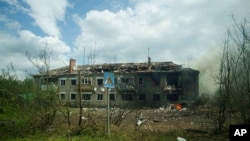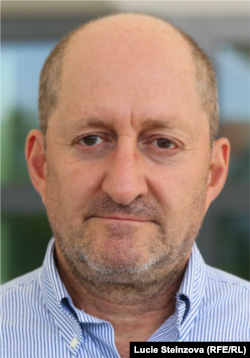
I'm Steve Gutterman, the editor of RFE/RL's Russia/Ukraine/Belarus Desk.
Welcome to The Week In Russia, in which I dissect the key developments in Russian politics and society over the previous week and look at what's ahead.
Amid a slew of developments from a military shakeup to tactical-nuclear arms drills and rumblings about changing maritime borders in the Baltic, images of Kharkiv region frontier towns targeted in a new Russian offensive are a stark reminder of the effects of Moscow’s unprovoked invasion of Ukraine.
Here are some of the key developments in Russia over the past week and some of the takeaways going forward.
Analyze This
For journalists, analysts, and pretty much anyone paying attention to the war in Ukraine, there’s always a lot to consider -- a wheeling constellation of developments that could hold clues to what the future may bring.
There’s the battlefield situation, weapons supplies, diplomacy, and frequent talk of the possibility of a truce – despite the fact that a cease-fire or negotiated solution seems far off at this point.
Sometimes, though, some detail -- a photo, a video, an anecdote -- brings one central fact into focus: Russia’s unprovoked invasion has killed and wounded hundreds of thousands of people.
This month, footage from Vovchansk, a town targeted in a new Russian offensive in the Kharkiv region, provided a stark picture of what’s happening: Death and destruction in an unprovoked war.
A short video posted on social media shows what appear to be three dead bodies lying on the ground -- two of them together and a third in a separate location, lying next to a bicycle.
The clip also shows broader views of Vovchansk, with smoke rising from ruins in a town that was intact two weeks ago but now looks like Bakhmut, Avdiyivka, and other cities Russian forces have destroyed since they launched the full-scale invasion of Ukraine in February 2022.
The result of the Russian offensive north of Kharkiv remains to be seen. Ukraine’s military asserted on May 24 that its forces had halted Russian advances there and were counterattacking -- but that the situation on other parts of the more than 1,000-kilometer front line was volatile.
Relentless
Russian is also hammering the city of Kharkiv, Ukraine’s largest after Kyiv and a symbol of resistance against Moscow since it avoided takeover by Russia-backed forces at the start of the war in the Donbas, further south, in 2014.
At least seven people were killed when a Russian missile strike hit a prominent printing press in Kharkiv on May 23, part of a wave of attacks that Ukrainian President Volodymyr Zelenskiy called “extremely brutal.”
Meanwhile, Russia has been taking steps to maintain pressure on the West as well as on Kyiv -- and to keep the world guessing about its intentions. And there are plenty of signs that the Kremlin is preparing for a long war as Putin’s new six-year presidential term gets under way.
One of them is his shake-up of the military leadership -- which is beginning to look more like a purge.
It seems to have several aims: To keep the war economy going, reduce corruption and ensure loyalty among the military brass, and deflect blame for setbacks in the war while showing the West that Putin has no intention of abandoning his effort to subjugate Ukraine and challenge the United States and Europe.
'Very Beneficial'
The Kremlin’s efforts to throw the West off balance go beyond Ukraine, of course, and include constant signaling and scare tactics. Two fresh examples: Russia’s most recent nuclear saber-rattling, with what it says are tactical nuclear weapons drills; and an elaborate warning that Moscow wants to redraw maritime borders in the Baltic.
Meanwhile, a Reuters report that cited unnamed Russian sources and said Putin “is ready to halt the war in Ukraine with a negotiated cease-fire that recognizes the current battlefield lines” was seen as the result of a Kremlin bid to paint Kyiv as recalcitrant and weaken Western support for Ukraine.
“Russia's minimum goal is to capture the rest of the Donbas, and I'm skeptical that Russia would pursue a cease-fire this year as long as it believes it can make further gains on the battlefield,” Rob Lee, a military analyst and senior fellow at the U.S.-based Foreign Policy Research Institute, wrote on X, formerly Twitter.
Putin’s “unchanging idea is that Ukraine must stop resisting and start discussing the terms of its capitulation,” political analyst Tatyana Stanovaya, an expert on the Kremlin and a senior fellow at the Carnegie Russia Eurasia Center, wrote on X.
A cease-fire would be “very beneficial for Putin: it allows him to keep what he has already taken, politically weakens the Ukrainian leadership, demotivates the West from supplying arms, and makes troop deployment useless,” Stanovaya wrote. “That’s how Putin intends to win the war.”
In December, Sam Greene, a political analyst and professor at the Kings Russia Institute, issued a similar warning after a previous instance in which the Kremlin appeared to be sending signals through the Western media that Putin was ready for talks on a cease-fire.
“Drawing the West into a negotiating process…serves an obvious purpose: it reduces the Western appetite for fighting and puts the Kremlin in control of escalation,” Greene wrote.
“If negotiations -- or even discussions about negotiations -- even temporarily slow the pace of Western financial, military and diplomatic support for Ukraine's war effort, they will achieve most of what Putin needs them to,” he wrote.
“The problem is this: For the West, negotiations are a means of ending the war. For Russia, they are a means of winning it.”
That's it from me this week.
If you want to know more, catch up on my podcast The Week Ahead In Russia, out every Monday, here on our site or wherever you get your podcasts (Apple Podcasts, Google Podcasts, Spotify, Pocket Casts).
Yours,
Steve Gutterman
P.S.: Consider forwarding this newsletter to colleagues who might find this of interest. Send feedback and tips to newsletters@rferl.org.






